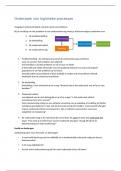Samenvatting
Summary Literature Communication & Leadership
- Instelling
- Universiteit Utrecht (UU)
Summary of all compulsory articles for Communication & Leadership as part of the social influence track of the Social, Health & Organizational Psychology master program
[Meer zien]













